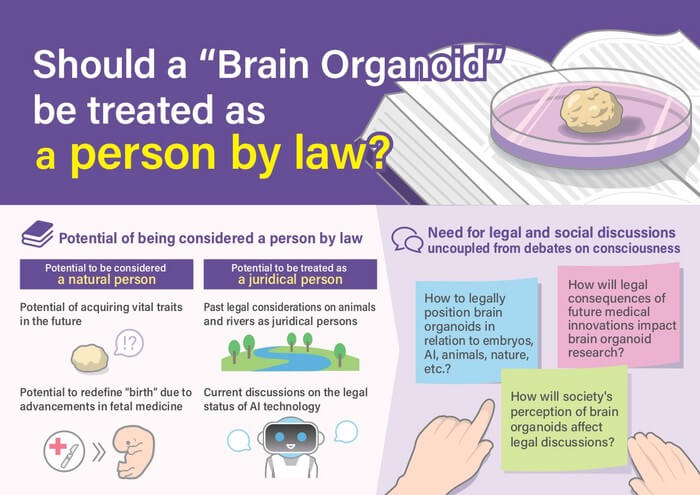Key Points
- Human brain organoids, which serve as a model of human brain development in miniature, raise profound questions about their potential personhood due to their structural and functional similarities to real human brains.
- While the moral status of these organoids has often been discussed, researchers from Japan and Taiwan argue for the necessity of a legal perspective in understanding and defining their status.
- Current brain organoid technology has not yet reached a stage where these organoids could be considered natural or juridical persons, but as technology advances, these issues are poised to become urgent.
Grown in the confines of laboratory environments, human brain organoids – a model of human brain development in miniature – are nurtured from stem cells and nourished by nutrient broth. These organoids, mimicking the growth and structure of portions of real brains, serve as a vital tool for scientists seeking a deeper understanding of the genesis and potential treatments of neural disorders. Yet, this raises a profound query: how closely do these organoids resemble actual human brains? Could they, in fact, be deemed individuals in their own right?
The conundrum is a complex one, riddled with moral and ethical intricacies. Yet, a group of researchers, hailing from Japan and Taiwan, suggest that a legal perspective may be pivotal in comprehending the potential personhood of these human brain organoids.
On the 3rd of April, they published their case for a legal framework, intended to navigate these uncharted waters, in the Journal of Law and Biosciences.
“The moral status of human brain organoids has often been discussed, but their legal status has rarely been discussed,” commented Tsutomu Sawai, the corresponding author and an associate professor in the Graduate School of Humanities and Social Sciences at Hiroshima University. “To clarify the legal status of human brain organoids will illuminate issues such as what information should be informed to the cell donor, to what extent the donor’s consent justifies the research, and what uses are acceptable.”
In legal terms, a ‘person’ could be any entity possessing legal rights and obligations. As Sawai elaborates, this could be a human (a natural person), defined by birth and the cessation of heart or brain function denoting legal death, or a non-human (a juridical person), such as corporations and governmental agencies.
In their publication, Sawai and his team delve into the application of these legal definitions of personhood to human brain organoids. At present, these organoids do not satisfy the fundamental criteria to be considered natural persons, yet ongoing research may yet bridge this chasm.
“Although human brain organoids do not constitute natural persons at present, the likelihood of their potential to become natural persons in the near future requires more thorough consideration in advance of that reality occurring,” noted Masanori Kataoka, the paper’s first author and a researcher at Hiroshima University’s Graduate School of Humanities and Social Sciences. “Research on linking human brain organoids with bodies is expected to advance rapidly in the coming years, whereas the conditions of natural personhood, especially viability and birth are becoming increasingly flexible and contentious.”
The researchers observed that previous discourse on this subject has been almost singularly focused on the aspect of natural personhood, leaving questions regarding potential juridical personhood of human brain organoids in the shadows. As Kataoka explains, the application of juridical personhood to human brain organoids would hinge upon any potential legal implications, and such considerations should be viewed independently from their status as natural persons.
“Current brain organoid technology is in many ways quite limited, and it has not yet reached a stage where human brain organoids could become natural or juridical persons,” Sawai concluded. “However, as we have emphasized, this issue will soon become urgent once brain organoid technology has been further developed. In preparation for that time, it is essential to examine the accompanying questions thoroughly and in advance; we have taken the first step in that direction.”
Frequently Asked Questions
1. What exactly are human brain organoids?
Human brain organoids are lab-grown entities nurtured from stem cells that mimic the growth and structure of portions of real human brains. They are used by scientists to investigate the origins and potential treatments of neural diseases.
2. Why is the question of personhood important for human brain organoids?
The question of personhood is pivotal due to the ethical, moral, and legal implications it carries. As organoids closely resemble the human brain, there’s a need to determine if they can be considered individuals in their own right, and how they should be treated and protected under the law.
3. What is the difference between natural and juridical persons in legal terms?
In legal terms, a natural person refers to a human, who is born of a womb and considered legally dead once their heart or brain stops functioning. Juridical persons, on the other hand, can be non-human entities such as corporations and governmental agencies, which hold legal rights and obligations.
4. What are the future implications of this research?
As brain organoid technology advances, the issue of their potential personhood is likely to become increasingly urgent. It’s necessary to thoroughly examine these questions in anticipation of future developments, and to prepare legal, ethical, and moral frameworks that can guide this emerging field.
If our reporting has informed or inspired you, please consider making a donation. Every contribution, no matter the size, empowers us to continue delivering accurate, engaging, and trustworthy science and medical news. Independent journalism requires time, effort, and resources—your support ensures we can keep uncovering the stories that matter most to you.
Join us in making knowledge accessible and impactful. Thank you for standing with us!

